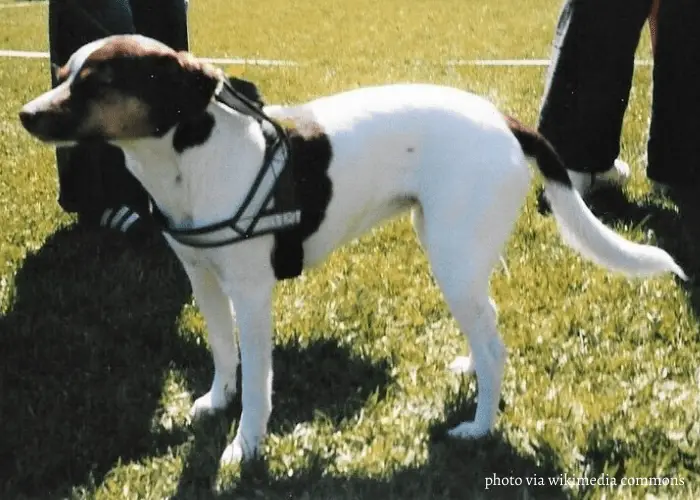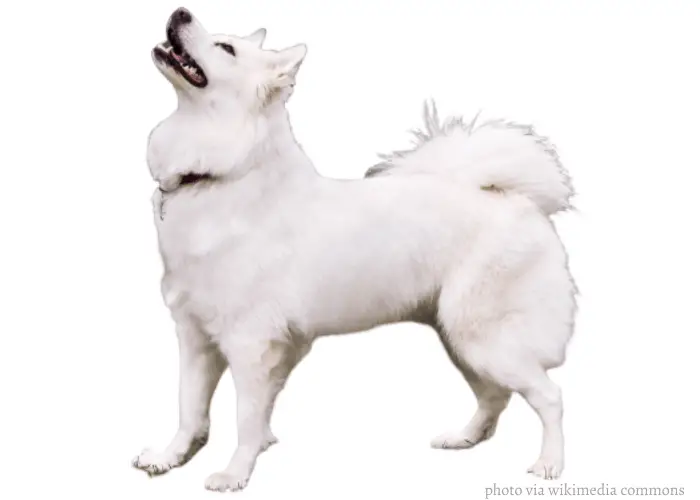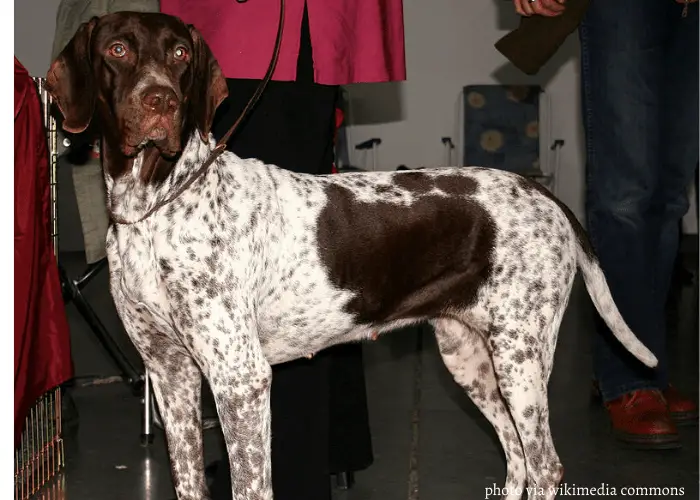Danish dog breeds have long been used for working purposes, including hunting, guarding, pointing, and even dog sledding.
Like many European breeds, several of the Danish dog breeds neared extinction during WWII.
Luckily, several different groups worked hard to re-establish the breeds and many of them have regained popularity and numbers in their homeland today.
While many of the breeds on this list are popular in Denmark and the surrounding area, few have moved on to gain popularity in North America.
Still, each of these breeds are beautiful and unique and deserve some recognition from each one of us.
For that reason, today we will be learning more about Danish Dog breeds including:
- Highlights and history of the breed
- Interesting facts about the breed
- Breed temperament
- Breed overview
- Frequently asked questions about the breed
So let’s not waste another minute:
1. Broholmer

Highlights: Good guardian, Friendly, Loyal
Sometimes referred to as the “Danish Mastiff”, the exact origins of the Broholmer breed are unknown.
Having said that, their history can be traced back to the Middle Ages, where they were commonly used as guardians for manors and farms.
Before they became guardians, they were also used for hunting stags.
The breed is a cross between the English Mastiff and several other German breeds, and they became very popular in the homes of the wealthy during the 19th century.
Sadly, like many breeds, the Broholmer almost went extinct during WWII. Luckily, a few remaining members of the breed were discovered in the 1970’s and efforts were taken by Broholmer fans to re-establish the breed.
Today, the breed owes its re-establishment to the Society for Reconstruction of the Broholmer Breed.
It was officially recognized by the UKC in 2006 and is now part of the AKC Foundation Stock Service.
DID YOU KNOW?
- The Broholmer was the chosen pet of King Frederick VII, which is where the breed can attribute its popularity in wealthy homes during the 19th
- The breed is named after an 18th-century gamekeeper known as Sehested of Broholm
- The most popular puppy name for the Broholmer is “Max.”
Temperament:

The Broholmer breed can be described as calm, social, and friendly.
Though they can be somewhat wary around strangers, they are extremely loving and affectionate towards members of their own family.
Despite its massive size, the Broholmer is relatively calm, prefers being at home, and is unlikely to stray too far from its family.
Though they love the outdoors, there is nothing that they want more than to be part of the family.
Leaving this breed alone for long periods can lead to extreme sadness and depression.
Though they can be somewhat standoffish with strangers, the Broholmer is very well-natured and good with people.
Unless they felt that they or their loved ones were under threat, this breed would never cause any harm to another.
They are extremely good with children, though caution should always be used due to their massive size.
Check Out dogs from other European countries below:
[table id=76 /]
Related Questions:
1. Is the Broholmer good with other animals?
If raised together from puppyhood, the Broholmer can do well with other dogs.
With that being said, it’s important to remember that this breed requires a great deal of attention and may become jealous of others.
So while they can get along with other dogs, they are best in homes where they can be raised alone.
Smaller animals like cats, hamsters, and birds should not be kept in the same home with the Broholmer as they still maintain some of their original hunting instinct.
2. What are the best toys for the Broholmer?
The Broholmer is a breed of dog that requires both physical and mental stimulation.
The breed loves dental chews, balls, knotted fiber bones, and doggie treat games.
Always make sure that any toys you provide for the Broholmer are large enough that they cannot swallow and choke on them, and always monitor when they are chewing on bones.
3. Do Broholmers drool a lot?
Yes, Broholmers do tend to drool more so than other breeds. They also tend to be extremely gassy and have a tendency to snore.
2. DANISH-SWEDISH FARMDOG

Highlights: Active, Playful, Outgoing
The Danish-Swedish Farmdog is often compared to the Jack Russell Terrier, not just for the similarity in appearance, but also for the similarity in temperament.
Originally developed to work on the farm, this breed often took on multiple roles both as a guardian and a hunter. They were often trained to hunt and catch a rat and other vermins.
Though the exact origins of the breed are unknown, the breed is thought to date back to the 1700s, where it was not only found in areas of Denmark, but also in areas of Sweden, Germany, and Britain.
They have been determined to be closely related to the pinscher family.
Sadly, as farms started to become less popular, the Danish-Swedish Farmdog breed started to die out and at one point, became at extreme risk of extinction.
Both the Danish and Swedish Kennel Clubs worked hard to find remaining Danish-Swedish Farmdogs and strived to re-establish the breed.
They were officially recognized as a breed in Denmark and Sweden in 1987. It became recognized by the ACK Foundation Stock Service in 2011.
DID YOU KNOW?
- In addition to its farm duties, the Danish-Swedish Farmdog has also been featured in many circuses acts as a sidekick to clowns.
- On July 1, 2015, the Danish Swedish Farmdog was approved for competing in herding events.
Temperament:

Like the breed that it is most often compared to (the Jack Russell), the Danish Swedish Farmdog is extremely alert and active.
This breed loves playtime with both humans and other dogs. The breed is extremely friendly and outgoing and is well-mannered among both family and strangers.
While the Danish Swedish Farmdog does well with other dogs, smaller pets like hamsters and birds may be at risk.
Introducing them to smaller pets at a young age can reduce the risk of attack, but it’s important to remember that this instinct is always there.
As a result, Danish Swedish Farmdogs should never be left alone with smaller pets or animals.
The Danish Swedish Farmdog breed is extremely alert, which makes them an excellent watchdog.
With that being said, they are not considered aggressive and are unlikely to attack unless extremely provoked.
[table id=77 /]
Related Questions:
1. Are the Danish Swedish Farmdogs easy to train?
Yes. This breed is extremely intelligent and tends to take well to training. For this reason, they are often seen in a wide variety of dog sports like agility training, flyball, and track and herding.
This breed responds best to calm, positive reinforcement when training.
2. Does the Danish Swedish Farmdog bark a lot?
Unlike many smaller breeds of dog, the Danish Swedish Farmdog does not have a tendency to be overly “yappy”. While they will bark to alert you that a stranger is near, they are relatively quiet otherwise.
3. What is the average litter size for the Danish Swedish Farmdog?
The average litter size for a Danish Swedish Farmdog is 2-4 puppies.
3. DANSK SPIDS (Danish Spitz)

Highlights: Kind, Vigilant, Good Companion
The Dansk Spid, commonly compared to the appearance of a small Samoyed, is of close relation to the German Spitz.
Throughout history, the breed has also gone by several other names, including the Samoyed-spitz, the wolf-spitz, and the Greenland-spitz.
In the 1700s, this breed was commonly used as a companion and guard dog. The breed was featured in several different paintings in the 1700s, but little is known about its history.
Today the breed is extremely rare and is virtually unheard of outside of its homeland.
DID YOU KNOW?
- The Dansk Spid was often referred to as “the children’s dog.”
- The Spitz family is considered to be one of the most ancient breeds of companion dogs in the world.
Temperament:

The Dansk Spids is a kind and social breed that does well with family, strangers, and other animals.
They are very loving and devoted to members of their family and are more than welcome to playtime with children.
The breed is alert and vigilant, making them excellent guard and companion dogs.
The breed is extremely intelligent and active and loves to play games and sports.
[table id=78 /]
Related Questions:
1. Does the Dansk Spids have a tendency to run away?
No. Though the breed does like to be outdoors and exercise, it tends to stay in close proximity to family members and doesn’t like to stray too far from its territory.
2. Does the Dansk Spid do well in dog sports?
Yes, the Dansk Spid is easily trainable, clever, and energetic. They do well with any kind of dog sport when trained at a young age.
3. Where can I buy a Dansk Spid in North America?
Unfortunately, it’s unlikely that you will find this breed in North America. They are extremely rare in their homeland, and almost unheard of outside of it.
4. GREENLAND DOG

Highlights: Strong, Independent, Loyal
The Greenland dog is an ancient breed of dog that has long been used within the Arctic regions as sled dogs for transportation and hunting.
Over time, the harsh weather conditions that the breeds were exposed to led them to develop the thick double coat of fur that they are most well-known for today.
The Greenland dog is thought to be one of the oldest dog breeds in the world, and even to this day, the breed is vital to life in Greenland.
Because they have strong survival instincts, this breed has developed to be extremely strong and healthy and is known to have very few health concerns.
While the breed is very beloved throughout Greenland, they are relatively rare outside of their homeland.
DID YOU KNOW?
- To date, there are approximately 15,000 sled dogs in Greenland.
- The Greenland Sled Dog is one of the few breeds of sled dogs seen North of the Arctic Circle.
- From 2002 to 2016, the sled dog population in Greenland has dropped by 40%. This is partly because of disease, partially because of the invention of the snowmobile, and partially due to climate change. For these reasons, the future of the Greenland Sled dog is uncertain.
Temperament:

The Greenland dog has long been a working breed and has therefore developed strong traits of independence.
While they can be very loyal to their masters, they often don’t have the opportunity to develop intense bonds because they are so often used in teams.
This breed of dog is happiest when they have a job to do, and would not be content to lie around the house all day. They require regular activity and strong leadership for training.
The Greenland hunting dog still holds much of its wolf-life instincts and has strong hunting skills.
With that being said, though their hunting instincts are strong, this breed does not make a good guardian and is unlikely to alert when strangers are near.
[table id=79 /]
Related Questions:
1. Can the Greenland dog live in an apartment?
No. The Greenland dog loves being outdoors and requires plenty of room to roam. They do not do well indoors or in high heat conditions.
2. Can the Greenland Dog live outside?
Yes. In fact, the Greenland dog prefers living outside to living indoors, even in cold weather conditions.
3. Does the Greenland Dog have any AKC standards?
To date, the Greenland dog is not recognized by the AKC. With that being said, it is recognized by the UKC under the working group.
It is also recognized by the FCI and the Canadian Kennel Club.
5. DANISH POINTING DOG (Old Danish Pointer)

Highlights: Patient, Devoted, Friendly
The Danish Pointing Dog is a medium-sized breed of dog that has long been used in pointing out a game.
Though they are not huge in stature, they are very muscular and strong and are packed with courage and determination.
The history of the breed dates back to 1710 when a man named Morten Bok decided to create his own breed of dog by breeding local farm dogs with Gypsy dogs. He named the new breed the Danish Pointer, or the Bakhound.
Its strong sense of smell made it a favorite among hunters of the 19th century and the breed remains very popular in Denmark today.
DID YOU KNOW?
- The UKC officially recognized the Danish Pointing Dog on January 1, 2006
- While male Danish Pointers are considered to be more muscular and powerful, the females tend to have more energy and have more impulsive tendencies.
Temperament:

The temperament of the Danish Pointer can best be described as peaceful, quiet, and stable.
Their devotion, friendliness, and fun-loving nature make them excellent family dogs.
They are considered to be patient towards children and strangers. They also do well with other dogs.
While the breed tends to be relatively calm indoors, they do require outdoor activity as well.
They tend to bond quickly with members of their family, but do tend stubbornness. For this reason, a strong, experienced owner is recommended.
[table id=80 /]
Related Questions:
1. Is the Danish Pointer a good choice for first-time dog owners?
Danish Pointers are an okay choice for first-time dog owners, but they do tend stubbornness.
For this reason, experienced owners with the ability to establish themselves as leaders of the pack will have the best training results with this breed.
2. Are Danish Pointers good with other pets?
Yes. Danish Pointers are generally good with other pets but tend to do much better when socialized with them from an early age.
The more socialization they have as puppies, the more tolerant and friendly they will be with other animals.
3. Is the Danish Pointer likely to stray?
No. When pointing and hunting game, the Danish Pointer is unlikely to stray. While they may travel slightly ahead, they prefer to remain close to their owner’s side.
Conclusion:
In conclusion, each of these different dog breeds brings their unique personalities and traits to their homeland of Denmark.
Whether they are hunting dogs, pointing dogs, sledding dogs, or just family companion dogs, they each deserve their praise and recognition for being exactly what they are – man’s best friend.
It’s not too late to see more European Dog Breeds below:

